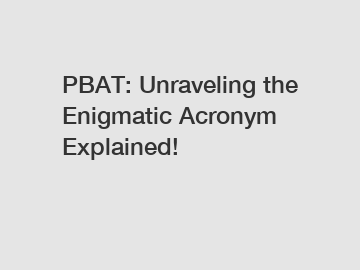PBAT: Unraveling the Enigmatic Acronym Explained!
PBAT: Unraveling the Enigmatic Acronym Explained!
What is PBAT, and why is it generating so much buzz? In the world of plastics and sustainable materials, PBAT has been making headlines as a promising solution to the growing plastic waste problem. While PBAT might sound like another complex scientific term, it stands for Polybutylene Adipate Terephthalate, a biodegradable and compostable polymer. Let's delve into the fascinating world of PBAT and explore its potential to revolutionize the way we think about plastics.
1. Understanding PBAT: .

PBAT is a type of biodegradable and compostable polymer that belongs to a broader family of aliphatic polyesters. It is synthesized by combining different monomers, including adipic acid, terephthalic acid, and 1,4-butanediol. The resulting polymer exhibits excellent mechanical properties, making it a viable alternative to traditional plastic materials. Additionally, PBAT is fully biodegradable under certain environmental conditions, breaking down into carbon dioxide, water, and organic matter.
2. Environmental Benefits:
One of the key advantages of PBAT is its reduced environmental impact. Unlike conventional plastics, which remain in the environment for hundreds of years, PBAT degrades relatively quickly, minimizing its contribution to pollution. Moreover, when PBAT ends up in composting facilities, it can be fully broken down by microorganisms, making it an ideal choice for industrial composting. This characteristic results in a closed-loop system, where PBAT can be transformed into nutrient-rich compost and used to cultivate crops or improve soil quality.
3. Potential Applications:
PBAT's versatility opens up a wide range of potential applications across different industries. From packaging to agriculture, textiles to medical supplies, PBAT can replace conventional plastics in various products. Its biodegradability makes it particularly suitable for single-use items, such as disposable cutlery, bags, and food containers. With the increasing demand for eco-friendly alternatives, PBAT presents an opportunity to reduce our reliance on fossil fuel-based plastics and move towards a more sustainable future.
4. Challenges on the Path:
While PBAT shows immense promise, there are challenges that need to be addressed before widespread adoption can occur. One aspect is the cost of production. Currently, PBAT is more expensive to produce compared to traditional plastics, posing a barrier to mass-scale manufacturing. However, with advancements in technologies and economies of scale, it is expected that the cost of PBAT production will decrease over time.
Another challenge lies in the composting and recycling infrastructure required for PBAT to reach its full potential. Industrial composting facilities play a crucial role in the proper disposal of PBAT, ensuring it is broken down efficiently. Moreover, separate collection systems for compostable plastics need to be established to prevent contamination of recycling streams. Collaborative efforts between governments, industries, and consumers can foster the development of these necessary infrastructures.
5. Sustainable Innovation:
PBAT is just one example of the continuous efforts made towards sustainable innovation in the plastics industry. As consumer awareness about the environmental impact of plastics grows, manufacturers are actively exploring alternatives that offer similar functionalities while minimizing harm to the planet. PBAT has emerged as a frontrunner in this pursuit, showcasing its potential as a game-changing material that aligns with the principles of the circular economy.
In conclusion, PBAT's entry into the plastics arena has sparked curiosity and hope for a more sustainable future. Its biodegradable nature, combined with its mechanical properties, positions PBAT as a promising alternative to traditional plastics. While challenges such as production costs and infrastructure exist, continued investment in research and development, coupled with collaborative efforts, can unlock the full potential of PBAT. As we strive to reduce plastic waste and its impact on the environment, embracing innovative solutions like PBAT is a step in the right direction. The question remains: Will PBAT pave the way to a plastic-free future? Only time will tell.
Contact us to discuss your requirements of What Is PBAT Plastic Used for, resin biodegradable, is resin biodegradable. Our experienced sales team can help you identify the options that best suit your needs.

Comments